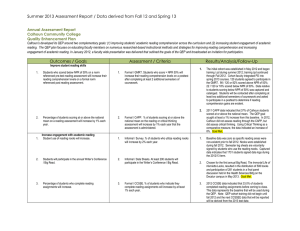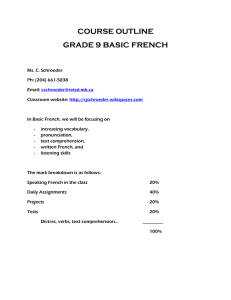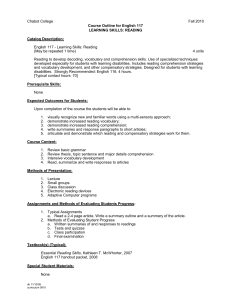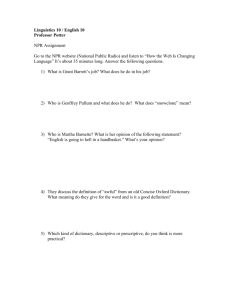Summer 2014 / data derived from Fall 13 and Spring... Annual Assessment Report Calhoun Community College
advertisement
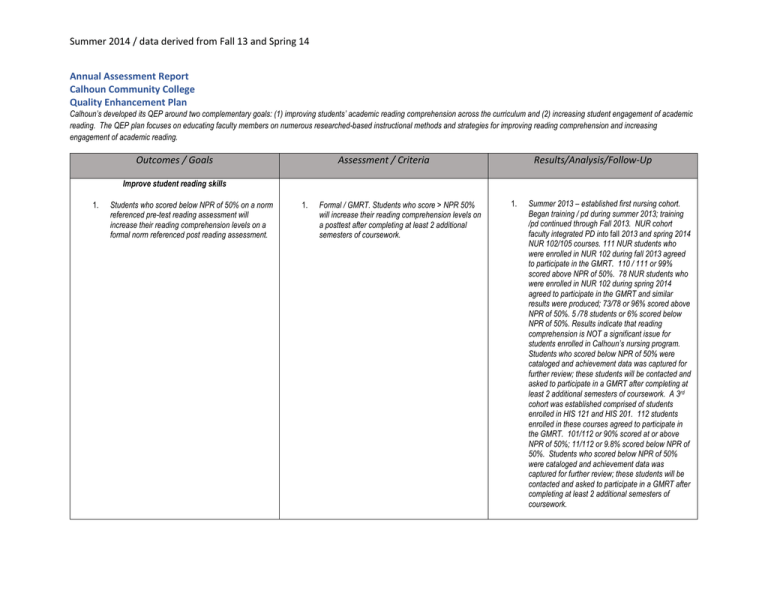
Summer 2014 / data derived from Fall 13 and Spring 14 Annual Assessment Report Calhoun Community College Quality Enhancement Plan Calhoun’s developed its QEP around two complementary goals: (1) improving students’ academic reading comprehension across the curriculum and (2) increasing student engagement of academic reading. The QEP plan focuses on educating faculty members on numerous researched-based instructional methods and strategies for improving reading comprehension and increasing engagement of academic reading. Outcomes / Goals Assessment / Criteria Results/Analysis/Follow-Up Improve student reading skills 1. Students who scored below NPR of 50% on a norm referenced pre-test reading assessment will increase their reading comprehension levels on a formal norm referenced post reading assessment. 1. Formal / GMRT. Students who score > NPR 50% will increase their reading comprehension levels on a posttest after completing at least 2 additional semesters of coursework. 1. Summer 2013 – established first nursing cohort. Began training / pd during summer 2013; training /pd continued through Fall 2013. NUR cohort faculty integrated PD into fall 2013 and spring 2014 NUR 102/105 courses. 111 NUR students who were enrolled in NUR 102 during fall 2013 agreed to participate in the GMRT. 110 / 111 or 99% scored above NPR of 50%. 78 NUR students who were enrolled in NUR 102 during spring 2014 agreed to participate in the GMRT and similar results were produced; 73/78 or 96% scored above NPR of 50%. 5 /78 students or 6% scored below NPR of 50%. Results indicate that reading comprehension is NOT a significant issue for students enrolled in Calhoun’s nursing program. Students who scored below NPR of 50% were cataloged and achievement data was captured for further review; these students will be contacted and asked to participate in a GMRT after completing at least 2 additional semesters of coursework. A 3rd cohort was established comprised of students enrolled in HIS 121 and HIS 201. 112 students enrolled in these courses agreed to participate in the GMRT. 101/112 or 90% scored at or above NPR of 50%; 11/112 or 9.8% scored below NPR of 50%. Students who scored below NPR of 50% were cataloged and achievement data was captured for further review; these students will be contacted and asked to participate in a GMRT after completing at least 2 additional semesters of coursework. Summer 2014 / data derived from Fall 13 and Spring 14 2. Percentage of students scoring at or above the national mean on a reading assessment will increase by 1% each year. 2. Formal / CAPP. % of students scoring at or above the national mean on the reading or critical thinking assessment will increase by 1% each year that the assessment is administered. 2. This data is unavailable for 2013; the CAAP was not administered based on the assessment schedule adopted by the College. 1. Informal / Survey. % of students who utilize reading nooks will increase by 2% each year. 1. Reading Nooks were created on both the Decatur and Huntsville campuses. Semester log sheets are voluntarily signed by students who use the reading nooks. Captured data indicates that 2237 students signed data logs during the 2013/2014 term. This is an increase of 486 students or 7.8%. Goal met. 2. Chosen for the second annual Big Read, All the King’s Men, resulted in the distribution of 600 books and participation of 312 students in a final presentation, “Political Idealism, Disillusionment, Accommodation, and Cynicism: Where the Historical and Literary Worlds of Willie Stark and Huey Long Intersect”, delivered by Wayne Flynt, Ph.D. held at the Madison County Public Library in May 2014. Goal met. Increase engagement with academic reading 1. Student use of reading nooks will increase. 2. Students will participate in the annual Writer’s Conference/Big Read. 3. 4. 2. Informal / Data Sheets. At least 200 students will participate in the Writer’s Conference / Big Read. Percentage of students who complete reading assignments will increase. 3. Formal / CCSSE. % of students who indicate that they complete readings or assignments will increase by 1% each year. 3. 2013 CCSSE data indicated that 34.3% of students complete reading assignments before coming to class. 2012 CCSSE data indicated that 33.0% of students completed reading assignments before coming to class. This change indicates an increase of 1.3% and suggests the goal was met. Percentage of faculty delivering and assessing instructional information to students through reading assignments will increase. 4. Informal / Survey. % of faculty delivering and assessing instructional information to students through reading assignments will increase by 10% as measured by a post QEP survey among campus wide faculty. 4. This data will be reported at the conclusion of the QEP. Summer 2014 / data derived from Fall 13 and Spring 14 5. Cohort faculty will continue to integrate specific reading comprehension strategies within their content area after cohort participation. 5. Informal / Survey. After QEP training, at least 70% of faculty cohort will continue to integrate specific reading comprehension strategies within their content area. . 5. 2012/13 QEP Faculty participated in a survey which indicated 0% relied upon the use of research based reading comprehension strategies in an effort to increase reading comprehension / reading engagement among their students. This same cohort completed a follow up survey in the fall 2013 to determine if cohort training / participation results in continued use of reading strategies outside of cohort participation. Data from this survey indicated that 100% of the initial cohort continued to integrate at least two reading comprehension strategies within their content area. Goal met.

